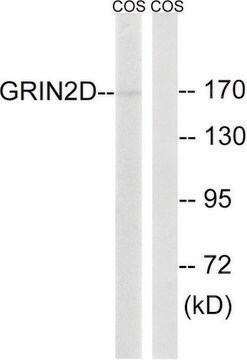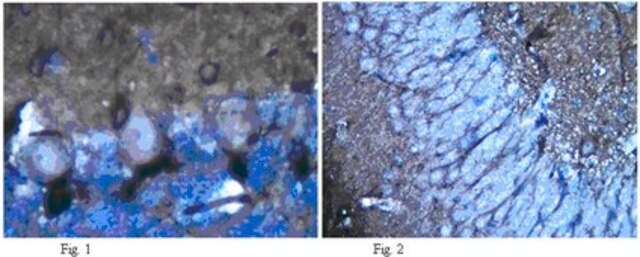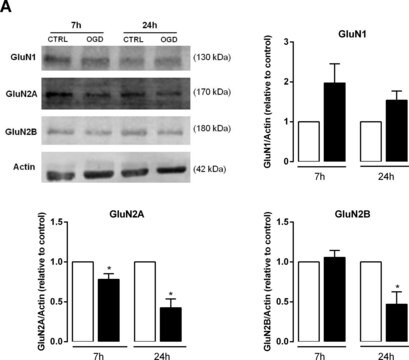MAB5578
Anti-NMDAR2D Antibody
ascites fluid, clone 1G9.39A5, Chemicon®
Se connecterpour consulter vos tarifs contractuels et ceux de votre entreprise/organisme
About This Item
Code UNSPSC :
12352203
eCl@ss :
32160702
Nomenclature NACRES :
NA.41
Produits recommandés
Source biologique
mouse
Niveau de qualité
Forme d'anticorps
ascites fluid
Clone
1G9.39A5, monoclonal
Espèces réactives
human, mouse, rat, rabbit
Fabricant/nom de marque
Chemicon®
Technique(s)
western blot: suitable
Isotype
IgG2b
Numéro d'accès NCBI
Numéro d'accès UniProt
Conditions d'expédition
dry ice
Modification post-traductionnelle de la cible
unmodified
Informations sur le gène
human ... GRIN2D(2906)
Spécificité
NMDAR2D, C-terminal. By Western blot the antibody reacts with a weak band at ~145. An additional band at ~75 kDa may be seen depending on sample and antibody concentration used.
Immunogène
Recombinant protein from rat NMDAR2D.
Application
Anti-NMDAR2D Antibody detects level of NMDAR2D & has been published & validated for use in WB.
Research Category
Neuroscience
Neuroscience
Research Sub Category
Neurotransmitters & Receptors
Neurotransmitters & Receptors
Western blot: 1:500-1:1,000 on rat brain lysate.
Optimal working dilutions must be determined by end user.
Optimal working dilutions must be determined by end user.
Forme physique
Liquid.
Stockage et stabilité
Maintain at -20°C in undiluted aliquots for up to 6 months after date of receipt. Avoid repeated freeze/thaw cycles.
Remarque sur l'analyse
Control
Rat forebrain or cerebellum.
Rat forebrain or cerebellum.
Informations légales
CHEMICON is a registered trademark of Merck KGaA, Darmstadt, Germany
Clause de non-responsabilité
Unless otherwise stated in our catalog or other company documentation accompanying the product(s), our products are intended for research use only and are not to be used for any other purpose, which includes but is not limited to, unauthorized commercial uses, in vitro diagnostic uses, ex vivo or in vivo therapeutic uses or any type of consumption or application to humans or animals.
Code de la classe de stockage
10 - Combustible liquids
Classe de danger pour l'eau (WGK)
WGK 1
Point d'éclair (°F)
Not applicable
Point d'éclair (°C)
Not applicable
Certificats d'analyse (COA)
Recherchez un Certificats d'analyse (COA) en saisissant le numéro de lot du produit. Les numéros de lot figurent sur l'étiquette du produit après les mots "Lot" ou "Batch".
Déjà en possession de ce produit ?
Retrouvez la documentation relative aux produits que vous avez récemment achetés dans la Bibliothèque de documents.
Sharon A Swanger et al.
The Journal of neuroscience : the official journal of the Society for Neuroscience, 35(48), 15971-15983 (2015-12-04)
The GluN2D subunit of the NMDA receptor is prominently expressed in the basal ganglia and associated brainstem nuclei, including the subthalamic nucleus (STN), globus pallidus, striatum, and substantia nigra. However, little is known about how GluN2D-containing NMDA receptors contribute to
Gajanan P Shelkar et al.
Scientific reports, 9(1), 7572-7572 (2019-05-22)
The GluN2C- and GluN2D-containing NMDA receptors are distinct from GluN2A- and GluN2B-containing receptors in many aspects including lower sensitivity to Mg2+ block and lack of desensitization. Recent studies have highlighted the unique contribution of GluN2C and GluN2D subunits in various
D J Laurie et al.
Brain research. Molecular brain research, 51(1-2), 23-32 (1998-01-14)
Mouse monoclonal antibodies were raised against bacterially expressed protein sequences of the NR2A, NR2B, NR2C and NR2D subunits of the rat NMDA receptor. From immunoblots of rat brain proteins, the apparent molecular weights of these subunits were 165, 170, 135
Jinxu Liu et al.
Neurobiology of disease, 150, 105254-105254 (2021-01-10)
Globus pallidus externa (GPe) is a nucleus in the basal ganglia circuitry involved in the control of movement. Recent studies have demonstrated a critical role of GPe cell types in Parkinsonism. Specifically increasing the function of parvalbumin (PV) neurons in
Jeremy S Lum et al.
Neurochemical research, 43(8), 1683-1691 (2018-06-25)
Dysfunction of the glutamatergic system is believed to underlie many neurodevelopmental disorders including autism, Rett syndrome and schizophrenia. Metabotropic glutamate receptor (mGluR5) positive allosteric modulators (PAM) potentiate glutamatergic signaling, particularly indirectly via the NMDA receptor. Preclinical studies report mGluR5 PAMs
Notre équipe de scientifiques dispose d'une expérience dans tous les secteurs de la recherche, notamment en sciences de la vie, science des matériaux, synthèse chimique, chromatographie, analyse et dans de nombreux autres domaines..
Contacter notre Service technique








